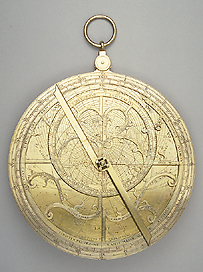
 |
| Catalogue |
 |
 Astrolabe The throne consists of a round plate with a swiveling plate fitted over it. The rete has a foliate scroll design outside the ecliptic; the solstitial bar inside the ecliptic above the equinoctial bar is broken into a heart shape. The star pointers are flame-shaped, the names of 39 stars are given with their magnitudes, some additionally with their Arabic names. The ecliptic is marked with the usual Latin names of the zodiacal signs, numbered 1 to 12. Each sign is divided to 30? numbered by 10? divided to 2?. The plate is marked on both sides with the circles for the equator (and 'AEQUATOR [Aries] [Libra] on 1a and 'AEQUINOCTIALIS' on 1b) and the tropics ([Cancer] on 1a and 'TROPIC<US> CANCRI' on 1b and 'TROPIC<US> CAPRICORNI'), azimuths for every 10? (numbered by 10?), almucantars for every 2? (numbered by 2?), the lines for the unequal hours (numbered 1 to 12), the lines for the astrological houses in the manner of Regiomontanus (numbered I to XII), the 'HORIZON OBLIQUS' and the twilight curve ('CREPVSCVLINA SIVE AVRORA'). The cardinal directions are marked (SEP{TENRIO}, OR{IENS}, ME{RIDIES}, OC{CIDENS}'). The two sides are marked and laid out for the following latitudes: 1a) 'LA{TITUDO} 45; 1b) 'AD ELE{VATIO} POLI' 48. The back of the instrument has several concentric scales as follows (from the outside): 1) An altitude scale, marked four times 0? to 90? starting on the east-west line, numbered by 10?, divided to 5? and subdivided to single degrees; 2) A scale with the usual Latin names of the zodiacal signs and the corresponding symbols, each sign divided to 30?, marked by 10?, divided to 5? with subdivisions to single degrees; 3) A Julian calendar scale marked with the usual Latin names of the months, divided to the corresponding number of days, every tenth day marked with divisions to five days and subdivisions to single days. The equinoxes correspond with March 101/2 and September 131/2; 4) A Gregorian calendar scale marked with the usual Latin names of the months, divided to the corresponding number of days, every tenth day marked with divisions to five days and subdivisions to single days. The bottom half of the vacant space inside these circles is taken up by a double shadow scale marked 'VMBRA VERSA' and 'VMBRA RECTA' to the base 12 and 60 respectively numbered by 3 and 10 digits respectively; the scale to the base of 60 is further divided to 5 digits and subdivided to single digits. The top half contains two horary quadrants laid out for equal and unequal hours for the same latitudes as the plates: on the left for latitude 45?, and on the right for latitude 48?. Neither the rule nor the alidade have any markings. The instrument was bequeathed to the Museum by Octavius Morgan in 1888 and is described by F. A. B. Ward, A Catalogue of European Scientific Instruments in the Department of Medieval and Later Antiquities of the British Museum (London, 1981), p. 119 ff., no. 342. Silke Ackermann |



